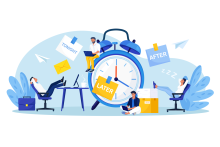

Across industries, locations and roles, the same challenges keep surfacing for Australian businesses: AI, digital transformation, regulatory change, and geopolitical uncertainty. What ties all of these together is the need for agility and adaptability.
KPMG’s Keeping Us Up at Night 2025 report highlights organisational agility as a defining capability to address these challenges into the future, emphasising that flexibility is no longer optional - it’s a requirement to stay competitive. But how do you create a business that is agile, scalable, and resilient?
While tools and systems such as project management software provide structure, the real enabler of agility lies deeper. At the heart of every adaptable organisation is the same foundation: communication and collaboration.
So, how can businesses build a culture of collaboration that strengthens agility and prepares them for long-term growth? The answer lies in leadership, culture, and capability - and it requires everyone to be part of the process.
Why collaboration drives agility
Agility in business means more than being able to respond quickly to external change; it means teams can adapt, innovate, and problem-solve together without losing focus or momentum. Yet many businesses struggle because teams work in silos, duplicate efforts, or fail to leverage expertise across the organisation.
Truly collaborative teams understand their interdependencies. They are clear about roles, share information freely, and celebrate collective wins. This reduces inefficiency, frees leaders to focus on strategy, and creates space for innovation.
But building this type of culture doesn’t happen by accident. It requires clear leadership decisions and consistent effort to shift behaviours and mindsets.
Three phases to building a collaborative, agile organisation
1. Build a foundation of trust and safety
A culture of collaboration begins with leadership setting the tone and building an environment of trust. When employees feel safe to speak up, share ideas, or admit mistakes, collaboration flourishes.
- Lead by example: leaders who show vulnerability and invite feedback signal that openness is valued.
- Foster psychological safety: encourage contributions without fear of criticism or retribution.
- Clarify goals and purpose: align teams around a clear mission and shared objectives.
- Promote open communication: use transparent processes, share information consistently, and make it easy for team members to connect across roles and functions.
This foundation not only strengthens collaboration but also ensures people are aligned and working toward common outcomes.
2. Develop leadership capabilities
Collaboration and agility require capable leaders at all levels, not just at the top. Developing leadership skills across your workforce creates resilience and spreads accountability. Areas to focus on include:
- Communication: active listening, empathy, and constructive dialogue are fundamental to collaboration.
- Emotional intelligence: leaders who understand and manage emotions build stronger, more engaged teams.
- Personal development: encouraging self-awareness helps leaders recognise blind spots and respond more effectively.
- Mentorship and shared learning: pairing experienced leaders with emerging ones helps transfer knowledge and foster growth.
- Practical, relevant training: tailor programs to real organisational challenges so leaders can apply skills immediately.
When leaders at every level are equipped to collaborate, businesses unlock hidden expertise, boost confidence, and create efficiency across teams.
3. Reinforce and sustain collaboration
Culture change requires ongoing reinforcement. Agility doesn’t come from one-off initiatives; it develops through consistent support and recognition. Businesses can embed collaboration by:
- Delegating power and responsibility: share decision-making and empower teams to take ownership of outcomes.
- Encouraging cross-functional collaboration: create opportunities for teams to work across departments, broadening understanding and problem-solving capacity.
- Celebrating wins: recognise collaborative achievements both formally and informally, encouraging repeat behaviours.
- Utilising collaboration tools: implement digital platforms that enable connection, knowledge sharing, and project tracking.
By weaving collaboration into everyday operations, businesses can ensure agility is not just a concept but a lived practice.
The role of leadership development
None of this is possible without effective leadership. The skills needed to build collaborative, agile organisations such as communication, people management, emotional intelligence, and change management, don’t come naturally to everyone. They must be developed, refreshed, and adapted to evolving workplace needs.
Leadership development programs provide the foundation for this growth. Short, targeted workshops can sharpen specific skills, while longer qualifications such as Certificates and Diplomas offer comprehensive capability building. Importantly, leadership development is not a one-time investment; it should be part of a continuous learning culture.
Identifying leadership potential early and offering opportunities to learn and practice ensures that businesses are not only collaborative today, but are also cultivating the next generation of agile leaders.
The bottom line
Agility isn’t just about moving faster, it’s about moving smarter, together. Collaborative teams, supported by strong leadership and a culture of trust, are more innovative, more resilient, and better equipped to navigate uncertainty.
At Aveling, we partner with organisations to design leadership and professional development programs tailored to these needs. Whether through solid inductions, comprehensive qualifications or targeted workshops, we help businesses build collaborative teams and agile leaders ready to meet the challenges of tomorrow.
Explore our leadership and professional development courses on our website at www.aveling.com.au, or contact us to create a training plan tailored to your organisation: +61 8 9379 9999













